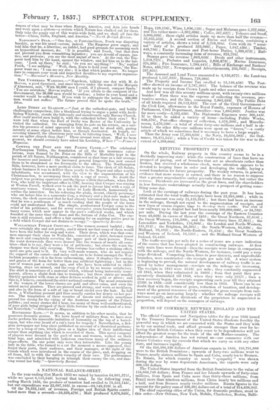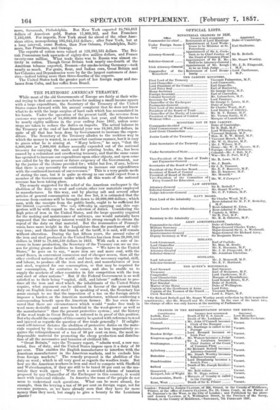BONDS OF COMMERCE BETWEEN ENGLAND AND THE UNITED STATES.
The official Commerce and Navigation tables for the year 1856 issued by the Treasury Department of the United States illustrate forcibly the powerful way in which we are connected with the States and they with us by our mutual trade, and afford grounds stronger than ever for believing that British Colonies when they cease to be dependencies will yet afford the greatest scope for the trade of the old Mother-country. The independence of America has not ruined us—our commerce with our former Colonies very far exceeds that which we carry on with any other state, and increases rapidly. Of the 310,586,330 dollars of American exports in 1856, 195,791,886 were to the British Dominions ; upwards of forty-two millions went to France, nearly sixteen millions to Spain and Cuba, nearly ten to Bremen. To Russia, for which country so much " sympathy " was shown during the war by some degenerate Americans, the exports were only 600,153 dollars. The United States imported from the British Dominions to the value of 154,056,749 dollars; from France and her Islands upwards of forty-nine millions, from Spain and Cuba more than thirty-three millions, from Brazil more than nineteen millions, from China nearly ten millions and a half; and from Bremen nearly twelve millions. Russia figures in the account for the paltry sum of 330,581 dollars out of a total of 314,639,942.
The chief exporting cities of the Union, for domestic produce, stood in this order—New Orleans, New York, Mobile, Charleston, Boston, Bahl
more, Savannah, Philadelphia. But New York exported 24,765,013 dollars of American gold, Boston 11,860,362, and San Francisco 7,182,088. For imports, New York stood far ahead of the other American cities, monopolizing 195,645,515 dollars ; after New York, but at a long interval, came Boston, then New Orleans, Philadelphia, Baltimore, San Francisco, and Oswego.
The exports of cotton were valued at 128,382,351 dollars. The British Possessions took upwards of eighty-five million dollars, and France twenty-one million. What trade there was to Russia was almost entirely in cotton. Though Great Britain took nearly one-fourth of the American tobacco exported, Bremen—for smoke-loving Germany—took nearly as much. For grain, flour, and Indian corn, Great Britain and her Colonies and Dependencies were by far the largest customers of America—indeed taking more than three-fourths of the exports. The United States took the greater part of her foreign sugar and molasses from Cuba, and her coffee from Brazil.



































 Previous page
Previous page